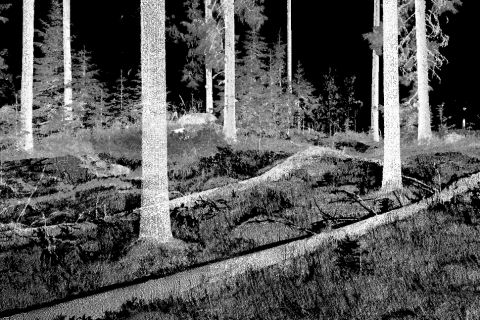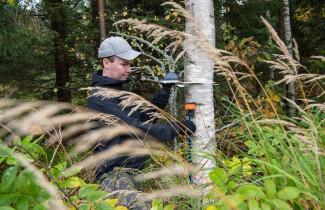Abstract
To better understand the underlying processes of many natural phenomena, accurate observations and measurements are needed to be carried out in space and time. Considering forest ecosystems, monitoring the development and dynamics of tree characteristics is essential in this regard. An era of three-dimensional (3D) sensing techniques and point clouds have revolutionised individual tree observations enabling measurements at an unprecedented level of detail. The feasibility of using point clouds to characterize trees and tree communities in space and their development in time was investigated in this thesis. The objective was to develop point cloud-based methods for distinguishing and characterizing trees and downed dead wood, and to test the feasibility of the developed methods in boreal forest conditions.
Point cloud-based methods for detecting and characterizing forest structure were developed in studies I-III. Downed dead wood trunks could be distinguished from the undergrowth vegetation and near-ground objects by means of their regular, cylindrical geometry. Smooth, cylindrical surfaces and vertical continuity, on the other hand, were the key characteristics of point cloud structures to separate woody structures of standing trees from foliage, and a tree stem from branches. Performance of the methods were tested in diverse boreal forest structures to validate these methodological principles.
The feasibility of the developed methods for characterizing trees and tree communities in space and time was tested in studies II-V. The structural complexity of a tree community was noticed as the most important factor affecting tree detection accuracy. High performance of the point cloud-based method was achieved on managed forest stands with low degree of variation in tree size distribution. In controlled thinning experiments, thinning intensity was found to be a more significant factor to affect the performance than thinning type (i.e., thinning from below, thinning from above, and systematic thinning). The hemispherical measurement geometry of terrestrial point clouds was successfully complemented with aerial point clouds acquired from above the canopy to improve the vertical characterization of trees and tree communities. Finally, the capacity of bitemporal terrestrial point clouds to characterize changes in the structure of trees and tree communities was demonstrated. If there was an increase or decrease in the attributes of trees within a tree community detected with conventional forest mensuration techniques, a similar outcome was achieved with the point clouds.
The findings of this thesis improve the current knowledge of the feasibility of using point cloud-based methods in observing tree characteristics. Detailed 3D reconstruction of forests expands the spectrum of tree observations as the dynamics of trees and tree communities can be monitored in more detail. This increases the understanding of processes shaping ecosystems and provides new approaches to improve ecological knowledge.
The doctoral dissertation of MSc Tuomas Yrttimaa, entitled Characterizing tree communities in space and time using point clouds will be examined at the Faculty of Science and Forestry on the 28 of May at 12 noon online. The opponent in the public examination will be Docent Ilkka Korpela, University of Helsinki and the custos will be Associate Professor Mikko Vastaranta, University of Eastern Finland. The public examination will be held in Finnish.
Link to the event (in Finnish)



